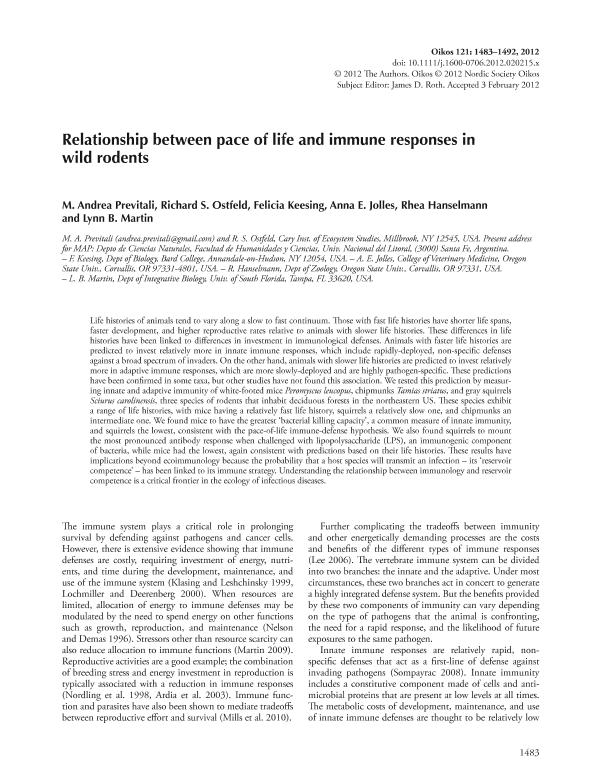Artículo
Relationship between pace of life and immune responses in wild rodents
Previtali, Maria Andrea ; Ostfeld, Richard S.; Keesing, Felicia; Jolles, Anna E.; Hanselmann, Rhea; Martin, Lynn B.
; Ostfeld, Richard S.; Keesing, Felicia; Jolles, Anna E.; Hanselmann, Rhea; Martin, Lynn B.
 ; Ostfeld, Richard S.; Keesing, Felicia; Jolles, Anna E.; Hanselmann, Rhea; Martin, Lynn B.
; Ostfeld, Richard S.; Keesing, Felicia; Jolles, Anna E.; Hanselmann, Rhea; Martin, Lynn B.
Fecha de publicación:
09/2012
Editorial:
Wiley Blackwell Publishing, Inc
Revista:
Oikos
ISSN:
0030-1299
Idioma:
Inglés
Tipo de recurso:
Artículo publicado
Clasificación temática:
Resumen
Life histories of animals tend to vary along a slow to fast continuum. Those with fast life histories have shorter life spans, faster development, and higher reproductive rates relative to animals with slower life histories. These differences in life histories have been linked to differences in investment in immunological defenses. Animals with faster life histories are predicted to invest relatively more in innate immune responses, which include rapidly-deployed, non-specific defenses against a broad spectrum of invaders. On the other hand, animals with slower life histories are predicted to invest relatively more in adaptive immune responses, which are more slowly-deployed and are highly pathogen-specific. These predictions have been confirmed in some taxa, but other studies have not found this association. We tested this prediction by measuring innate and adaptive immunity of white-footed mice Peromyscus leucopus, chipmunks Tamias striatus, and gray squirrels Sciurus carolinensis, three species of rodents that inhabit deciduous forests in the northeastern US. These species exhibit a range of life histories, with mice having a relatively fast life history, squirrels a relatively slow one, and chipmunks an intermediate one. We found mice to have the greatest ‘bacterial killing capacity’, a common measure of innate immunity, and squirrels the lowest, consistent with the pace-of-life immune-defense hypothesis. We also found squirrels to mount the most pronounced antibody response when challenged with lipopolysaccharide (LPS), an immunogenic component of bacteria, while mice had the lowest, again consistent with predictions based on their life histories. These results have implications beyond ecoimmunology because the probability that a host species will transmit an infection – its ‘reservoir competence’ – has been linked to its immune strategy. Understanding the relationship between immunology and reservoir competence is a critical frontier in the ecology of infectious diseases.
Palabras clave:
Ecoimmunology
,
Pace of life
,
Rodents
,
Immnune responses
Archivos asociados
Licencia
Identificadores
Colecciones
Articulos(CCT - SANTA FE)
Articulos de CTRO.CIENTIFICO TECNOL.CONICET - SANTA FE
Articulos de CTRO.CIENTIFICO TECNOL.CONICET - SANTA FE
Citación
Previtali, Maria Andrea; Ostfeld, Richard S.; Keesing, Felicia; Jolles, Anna E.; Hanselmann, Rhea; et al.; Relationship between pace of life and immune responses in wild rodents; Wiley Blackwell Publishing, Inc; Oikos; 121; 9; 9-2012; 1483-1492
Compartir
Altmétricas



